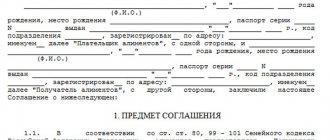Prices for services for collecting alimony penalties
Basic services for drawing up a sample claim and collecting alimony penalties
| Consultations | from 3 000 |
| Preparing a claim for the recovery of alimony penalties (sample below) | from 5 000 |
| Claim work | from 8 000 |
| Representation in court | from 20 000 |
| Appealing a court decision | from 15 000 |
| Collection of evidence confirming intentional evasion of alimony payments | from 10 000 |
| Calculation of the penalty intended for recovery under the claim | from 3 000 |
| Preparation of a package of additional documents to be attached to the claim for the recovery of a penalty | from 3 000 |
Additional services for collecting alimony penalties through the court
| Obtaining a court decision | from 2 000 |
| Obtaining a writ of execution | from 2 000 |
| Transfer of the writ of execution to the defendant’s employer or to the bailiff service | from 4 000 |
| Initiation of a ban on traveling abroad due to non-payment of a penalty for a claim | from 5 000 |
| Challenging a court decision that reduced the amount of the penalty | from 15 000 |
What determines the amount of alimony penalties?
The penalty for alimony is calculated according to a strictly fixed formula, which includes such indicators as: the amount of the total alimony debt on the day of consideration of this issue and the time period of delay (period).
The principal amount of the debt is obtained by adding up all payments that should have been paid from the moment the debt arose until the day the issue of collecting the penalty was considered. The period of delay refers to the total amount of time during which alimony was not paid: 2, 3 months or 1 year.
Responsibility for non-payment of alimony
If the alimony payer evades fulfilling this obligation, then the liability provided for in Art. 115 of the RF IC for untimely transfer of money to pay alimony. The extent and degree of liability depends on whether an agreement was concluded between the parties or whether the payer was obliged to pay money in connection with the relevant court decision. If an agreement was concluded between the parties, then liability for the occurrence of debt is determined by its terms. When the payer is obliged to transfer money by a court decision, if a debt arises, a penalty is collected from him according to a claim drawn up according to the sample.
Attention! The amount of the penalty is determined by Federal Laws No. 224 of 2021 and No. 106 of 2008, in accordance with the provisions of which it is 0.1% of the debt amount for each day of delay.
The court has the right to reduce the amount of the penalty for the claim (see sample document), based on a number of factors:
- Financial situation;
- Family status;
- Disproportionality of the amount of the penalty on the claim to the consequences of non-payment of alimony.
The recipient has the right, in addition to a penalty, to demand compensation in a lawsuit for losses incurred due to late payment of alimony.
How to calculate the penalty for alimony
The court's decision to collect a penalty will be based on its calculation, so this calculation should be made very carefully.
The calculation of the penalty for alimony, which is collected by court decision, is based on the amount of debt for each month. That is, the delay (number of days) is determined for each unpaid month separately from the first day of delay (for a specific month) until the date of the court decision. And then the results of all the penalties add up. The amount of the penalty, or rather the penalty rate, for each day is equal to 0.5% of the debt amount .
At the time of filing a claim, it is impossible to know exactly when a decision will be made. Therefore, first I make a preliminary calculation for the date of filing the claim. Then, when the day for the consideration of the case is set, they make a clarifying calculation for this date - the day the court decision is made.
The procedure for calculating the penalty under an agreement on the payment of alimony, including the amount of the rate, is determined by such agreement.
The penalty is often calculated by simply multiplying the total debt by 0.5% and the total number of days of delay. However, judicial practice on the collection of alimony penalties indicates that such an approach to calculation is incorrect.
The penalty for alimony should be calculated using the formula:
A x 0.5% x D = N, where A is the amount of unpaid alimony for a specific month; D - the total number of days of delay in payment of alimony; N - amount of penalty.
Further, the penalties for each month are summed up by ordinary arithmetic addition.
Example of penalty calculation
The alimony debt amounted to:
- March 2021 — 10,000 rub.
- April 2021 — 15,000 rub.
- May 2021 — 17,000 rub.
Calculation:
- 10,000 rubles (for March) x 92 (days) x 0.5% = 4,600 rubles;
- 15,000 (for April) x 61 (day) x 0.5% = 4,575 rubles;
- 17,000 (for May) x 31 (days) x 0.005 = 2635 rubles.
4600 + 4575 + 2635 = 11,810 rubles (penalty as of June 1, 2021).
Collection of alimony penalties through the court (see sample claim)
The penalty is collected through the court, subject to the fulfillment of all actions provided for by law. It is necessary to carry out claims work aimed at notifying the payer about the debt, on the basis of which a claim is subsequently filed in court. This procedure for collecting penalties on a claim is provided due to the fact that the payer may not be aware of his obligation to pay alimony if the corresponding decision was made in absentia or in the form of a court order.
Attention! It is considered mandatory to comply with the statute of limitations when collecting penalties on a claim, since the recipient can only expect payment of penalties accrued over the last 3 years.
In order for the court to make a positive decision on the claim and satisfy the demand for a penalty, the applicant must prove that the debtor has the ability to pay. You can confirm the defendant’s guilt by supporting the claim and proving the following facts:
- The person refuses to pay his allowance;
- Attempts are being made to conceal the location;
- The true amount of earnings is hidden;
- Warnings from the bailiff about the likely initiation of criminal proceedings in case of non-payment of debt.
Is it possible to reduce the amount of the alimony penalty?
In judicial practice on the collection of penalties for alimony, there have been discussions for quite a long time on the topic of the possibility of reducing the legal penalty for alimony on the basis of Art. 333 Civil Code of the Russian Federation. At the same time, as a rule, the courts of the first and appellate instances believed that the penalty cannot be reduced, since its proportionality is defined in the Family Code of the Russian Federation. The higher courts, on the contrary, believed that the penalty should be reduced, and applied the rules of Art. 333 of the Civil Code of the Russian Federation, which allows you to reduce the amount of the penalty if it is much greater than the obligation itself (alimony debt).
All discussions and disputes ended in 2012, after the Supreme Court of the Russian Federation clarified that alimony is maintenance for needy family members, and the legislation recognizes these circumstances as socially respectful. There is a special norm - Art. 115 of the RF IC, which determines the extent of liability for failure to provide maintenance, and this norm does not provide for a reduction in the penalty .
Since alimony obligations have certain features, Art. 333 State Administration of the Russian Federation. Accordingly, a reduction in the penalty for alimony is not allowed.
Preparing a claim for the recovery of alimony penalties - sample application
A sample claim for the recovery of a penalty is drawn up taking into account a number of basic requirements, taking into account the jurisdiction of the case and the general rules developed for preparing sample claims. Jurisdiction of the case depends on the amount of the penalty and is determined by Art. 23 – 24 Civil Procedure Code. If the amount of the fine does not exceed 50 thousand rubles, then the magistrate will deal with the case. When the penalty is greater, a sample claim is filed with the district court. You are required to provide basic information:
- Information about the defendant and plaintiff: residential address, contacts, full name;
- The essence of the claim with arguments justifying the formation of the penalty and confirmed by the attached evidence;
- Request for forced collection of money.
In order to correctly draw up a claim for the recovery of alimony penalties (sample), you need to fully disclose the topic.
The plaintiff can indicate in the sample claim any information that he deems necessary, but must adhere to a clear structure, which includes the following mandatory points:
- Amount of claims indicating exemption from payment of state duty;
- List of attached documentation;
- Date of writing and signature of the plaintiff.
Attention! The claim is prepared in 2 copies, since the second sample application is sent to the defendant.
Documents for filing a claim (see sample application)
The attached package of documents must include the passport of the plaintiff and the defendant, if available, as well as the birth certificate of the children and the document on the basis of which alimony is paid, as a rule, this is an agreement signed between the parties or a copy of the court decision. You will need to attach receipts of the last payment made by the payer, a certificate of the amount of debt from the FSSP. If a sample claim for the recovery of alimony penalties is filed by a lawyer, then a power of attorney is drawn up in his name, certified by a notary.
Fee for filing a claim (sample above)
Filing a sample claim to the court is traditionally subject to a state fee, but in the case of payment of alimony, the plaintiff is recognized as a person protecting his interests. Therefore, he is exempt from paying a fee of 150 rubles, which is enshrined in Art. 333.36 Tax Code. The fee will be collected from the defendant if, at the end of the trial, the court satisfies the claim and obliges him to pay a penalty for alimony.
Penalty for alimony: collection procedure
Action 1.
It is necessary to collect all the documents that confirm the debt, as well as calculate the amount of the penalty.
The amount of alimony debt is determined by the order of the bailiff.
The basis for the bailiff service official is a court decision or agreement of the parties.
Depending on the basis for paying alimony, it is necessary to calculate the amount of the penalty:
- agreement of the parties - in accordance with the terms of liability of the parties;
- court decision - in the amount of 1/2% of the amount of unpaid alimony for each day of delay.
Action 2.
It is necessary to prepare a statement of claim
A sample statement of claim can be downloaded here.
The statement of claim must include the following information:
- name of the court to which the application is filed;
- the name of the plaintiff, his place of residence or, if the plaintiff is an organization, its location, as well as the name of the representative and his address, if the application is submitted by a representative;
- the name of the defendant, his place of residence or, if the defendant is an organization, its location;
- what is the violation or threat of violation of the rights, freedoms or legitimate interests of the plaintiff and his demands;
- the circumstances on which the plaintiff bases his claims and evidence supporting these circumstances;
- list of documents attached to the application.
Attach the following documents to the statement of claim (Article 132 of the Code of Civil Procedure of the Russian Federation):
- a copy of the court decision on the collection of alimony or an agreement on its payment;
- a copy of the child's birth certificate;
- a copy of the bailiff's resolution on debt settlement;
- calculation of the amount of the collected penalty;
- a copy of the statement of claim for the defendant.
As a rule, plaintiffs are exempt from paying state fees; such a fee is collected from the defendant in the amount of 150 rubles.
It is necessary to pay attention to the fact that the plaintiff’s legislation does not exempt the plaintiff from paying state duties; the situation described above is the practice of judicial activity on similar issues.
Thus, when filing a statement of claim, it is necessary to pay a state fee in order to avoid the risk of the court leaving the claim without progress.
During the trial, you can petition the court to collect state fees from the defendant. Or, in the text of the statement of claim, enter a request for exemption from paying state fees.
For example, in accordance with paragraphs. 2, 15 p1 tbsp. 333.36 of the Tax Code of the Russian Federation, I ask you to exempt the plaintiff from paying state duty, ...
Action 3.
It is necessary to file a claim in court and take part in a court hearing
In accordance with Art. 28 of the Code of Civil Procedure of the Russian Federation, the statement of claim is submitted to the magistrate at the place of residence of the defendant.
The court must accept such an application within 5 days from the moment it is received by the court, if the filing of the claim and its form comply with the requirements of the law.
If the court makes a positive decision in favor of the plaintiff, it is necessary to obtain a writ of execution to enforce the collection of the penalty.
Action 4.
Submitting a writ of execution to the bailiff service
It is necessary to submit an application to initiate enforcement proceedings, attaching a writ of execution and bank account details where the collected funds will be transferred by the bailiff.
Also, the recipient of alimony has the right to demand from the payer to cover losses caused by the delay in fulfilling alimony obligations.
This applies in part to the uncovered penalty (clause 2 of Article 115 of the RF IC).
Additional instruments of pressure on the debtor
During the consideration of a claim, there are additional ways to put pressure on an unscrupulous defendant. In addition to collecting a monetary penalty, the court may take additional measures on the claim aimed at exerting pressure to comply with the decision:
- Bringing to administrative liability in the form of a fine;
- Ban on travel outside Russia;
- Recovery of damages incurred due to non-payment of alimony;
- Criminal liability.
Author of the article
Who can file a claim for a penalty?
In the event that, for some good reason, the legal representative of a minor who must receive alimony cannot file a claim for the recovery of a penalty, he has the legal right to send an application to the prosecutor requesting the recovery of such a penalty.
As follows from Art. 45 of the Civil Code of the Russian Federation, the prosecutor has the right to personally apply to the court in order to protect family, motherhood and childhood on behalf of the state. In this case, the prosecutor has all the rights provided for the plaintiff and all his obligations, with the exception of the right to a settlement agreement.










